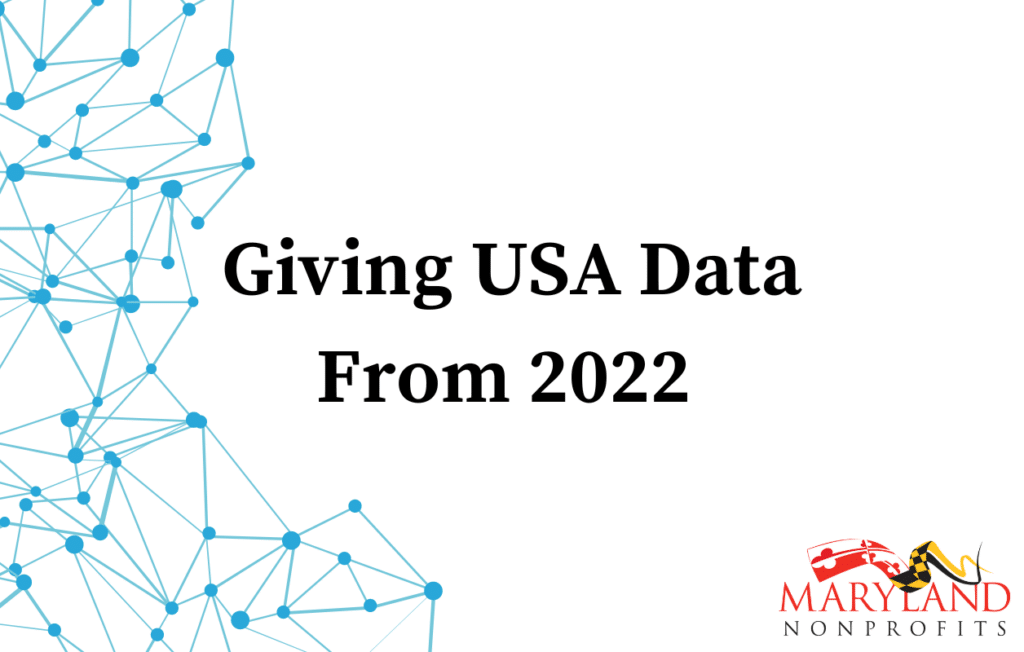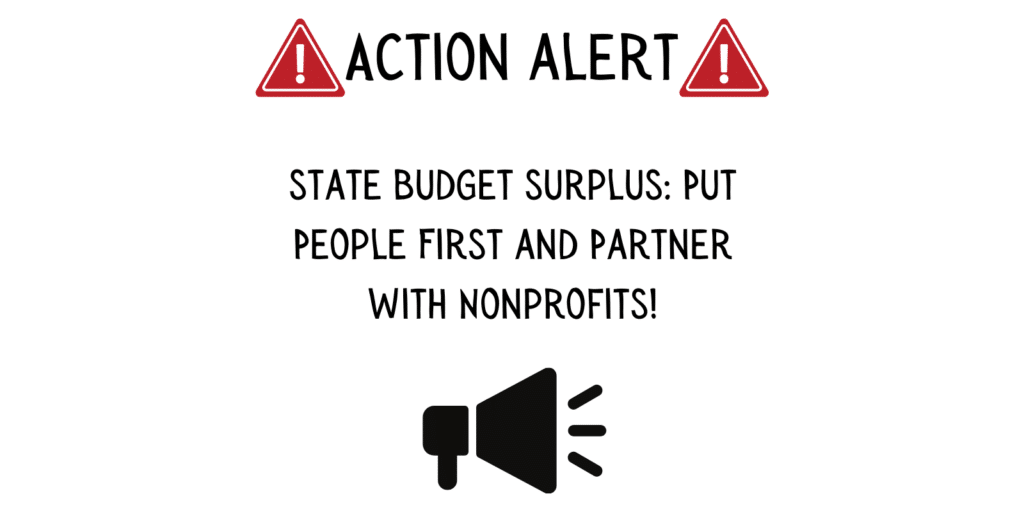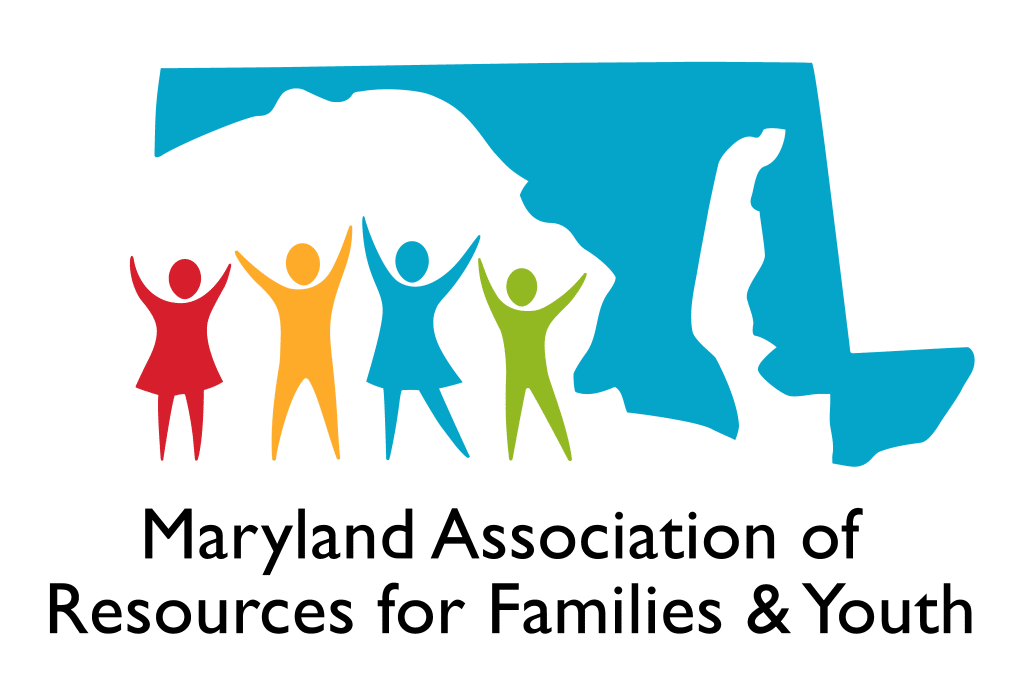A lot of state-level nonprofit advocacy in Maryland is focused on legislation under consideration by the state legislature during its 90-day session from January to April.
There are other important policy processes where you can and should advocate to advance your nonprofit’s programs and missions. These include shaping the implementation of programs within the executive branch, grassroots lobbying to build public support for your nonprofit’s mission, and advocating for items in the budget.
This blog post is about budget advocacy.
You may want to advocate for budget items that directly fund your programs: either to create a new state funding stream, to increase your funding, or simply to protect your existing funding level. This could be a grant to your organization, or it could be funding for a program that benefits your organization and others, like behavioral health programs or the Arts Council.
You may also advocate for budget actions that promote your nonprofit mission, even if the dollars do not come directly to your organization. Funding for school nutrition programs, public assistance, or improved staffing of state agencies might fit this category.
Either way, there are some general principles for effective budget advocacy. They apply this year as much as ever.
There are also some specific circumstances this year that will deserve special attention this year.
- The state has a substantial budget surplus (though probably not as substantial as a year ago).
- There will be a transition of administrations in the middle of the budget process this year. The new budget must be presented to the legislature just two days after the new governor is inaugurated.
- For the first time, an amendment to the Maryland Constitution takes effect that allows the legislature to re-arrange funds within the budget proposed by the Governor.
The Surplus. As we explained in the last Action to Care blog entry, state general fund revenues totaled $24.05 billion during the last fiscal year(July 2021 through June 2022). That exceeded the final estimates by $1.57 billion. At the end of the last fiscal year on July 1, the state’s general fund “bank balance” was $5.5 billion. Some of that money was already spoken for. So the “unassigned” general fund balance was $1.12 billion.
That is the key number, but not the final number. The Board of Revenue Estimates has announced revised estimates for revenue in the current year and next year. They are about $1.2 billion above the previous estimates in both the current fiscal year 2023 and the upcoming fiscal year 2024. That will increase the size of surplus available within Maryland’s balanced budget requirement to the $3 billion to $3.5 billion range.
That number will be further refined based on final revenue estimates in December, and on updated estimates of baseline expenditures.
In any event, there will be a significant budget surplus. And that makes for a less tense budget environment than when the budget is in a projected deficit, or just barely balanced. So, it’s an opportune time to be advocating for increased funding. Still, the budget surplus will be considerably less than the estimated surplus was this time last year. And, of course, there will be strong competition for the limited funds.
Also, budget hawks will be averse to committing the whole surplus to ongoing expenses. For two reasons:
- Much of the increased revenue is from sources that may not repeat in the current and upcoming year – mainly capital gains.
Budgeters don’t like to expend one-time revenue on ongoing expenses – like staffing and grants and contracts for continuing nonprofit services. They will prefer to use one-time surplus for one-time uses: building up reserves, oner-time construction and information technology projects, employee bonuses, and one-time tax rebates, for example. If your request is legitimately for one-time funding, that will give you an advantage,
- There are a variety of external risks to the rosy budget projections:
- Inflation, which could cause state government expenses to grow faster than revenues.
- Recession which could cause individual income tax, corporation tax, and sales tax revenue to slump.
- Any number of natural or man-made disasters, from floods, to wars, to civil disturbances, could damage the economy or cause unexpected expenses.
These concerns will prompt budgeters to want to hold down new spending and build up reserves.
The Transition. The new governor will present their proposed budget just two days after taking the oath of office.
As a practical matter, most of the work on the budget will be done by the outgoing administration (and the career professionals at the Department of Budget and Management). After the election results are in, the governor-elect and their transition team will become involved in finalizing the budget. (This is now a matter of law. In 1994-95, Governor Schaefer refused to cooperate with the incoming Glendening administration, and two budget bills were actually submitted to the legislature: one from Governor Schaefer before Inauguration Day and one from Governor Glendening after Inauguration Day. The following year, the legislature passed a bill to govern the budget process during a transition of administrations.)
Lobbying the old crowd. It is worth your time and effort to lobby the current administration to include your item in their version of the budget. I do not know if the outgoing administration will include new initiatives or enhancements in the draft budget they turn over to the incoming administration. But they might.
I have been surprised in the past how often the new administration retains new budget items the old administration put in the budget – especially in the case of discretionary grants.
Direct your communication to Governor Hogan; Lieutenant Governor Rutherford; Chief of Staff Alcivar; any Deputy Chiefs of Staff or senior staffers who you know to be involved in your issue area; Budget and Management Secretary Brinkley; and the current head(s) of the state agency or agencies related to your program.
Lobbying the new crowd. It is also very important to lobby the incoming administration. But it’s trickier, because things are very fluid during the transition, and it can be hard to identify the key people.
After the election, look for an announcement of a transition team, and transition staffers or committee chairs assigned to the budget and to your subject matter. Write or email to the Governor-elect and Lieutenant Governor-elect at the transition office, and to any transition team members or staffers that seem like promising prospects.
If you were successful with the old administration (which you probably won’t know because the draft budget is not public), making contact with the transition team could help you to keep your item in the budget.
If the outgoing administration’s draft budget did not include your request, you would want it to be on the next team’s menu of budget options, and you would want to have some of your supporters on that team.
The new administration will want to fund initiatives related to their program. So look up the victorious campaign’s policy positions. Relate your budget proposal to their stated priorities if there’s a connection.
The initial budget is not your only chance with the new administration. The new governor may submit one or more “Supplemental Budgets” after the initial budget is introduced. Don’t feel completely defeated if your item is not included in the original budget.
The Constitutional Amendment. In the upcoming legislative session, the legislature will have more power over the budget than it has had in over a century. In the 2020 election the voters approved a constitutional amendment (“Question 1”) to allow the legislature to rearrange funds in the governor’s proposed budget, but not to add to the total.
That change takes effect in the upcoming legislative session in 2023.
If the legislature does add or increase an item in the budget, the Governor now has the ability to veto the addition or increase, and the item reverts to the amount proposed by the Governor. The legislature may then reconvene in special session within 30 days to consider overriding the veto. An override requires three-fifths of the votes in both the Senate and the House of Delegates.
Even with this change, the Governor’s power over the budget remains very strong. By proposing the budget in the first place, the governor creates a “baseline.” Legislators who want to depart from this baseline, say by increasing funding for a program that helps your organization’s customers, have the burden of convincing a majority of members on the budget committees in both houses and the appropriate subcommittees to approve the increase, and then to get the amendments approved in identical form by the full Senate and House of Delegates.
Also, since the legislature cannot increase the total of the budget, they will need to approve an equivalent cut somewhere else in the budget to offset the addition.
Since this is a new process, and a newly elected legislature will be seated next year, no one really knows how the legislature’s budgeters will use this “Question 1” authority, and what will be the procedures and tactics.
Question 1 and Your Budget Item. The legislature’s new authority gives you a third bite at the apple this year. (The first two were the outgoing Hogan administration and the transition team for the new administration). Even under the old rules, we used to advise you to communicate with key legislators to keep your item in the budget if it’s in the governor’s budget. That still applies.
Getting the legislature to add your item under their Question 1 authority should be “Plan B.”
It would be good to contact some key legislators both before session, and closer to budget decisions in February.
Who are key legislators? You want to enlist champions who are interested in and knowledgeable about your organization and its mission, and who have influence in the budget process in the Senate and the House of Delegates. You usually can’t get all of that in the same person. So, you will have to approach multiple potential champions. Here are some good legislators to think about.
- Legislators who you have worked with before, and who are already familiar with you and your organization.
- Legislators who represent the district where your organization and/or your project is located.
- The chairs of the Senate Budget and Taxation Committee and the House Appropriations Committee, and the Senate and House subcommittees that cover your budget area.
- Other members of the appropriate budget subcommittees.
- Other budget committee members.
- Legislators who are considered experts in your subject area.
More Budget advocacy tips.
Have a specific “ask” and a solid business case. The first paragraph of your letter or email should state the dollar amount you are asking for and describe your proposed program, project or initiative.
You should clearly state the benefits of your proposal in very concrete terms. Back up your business case with stories and with numbers.
Other selling points you might put forward include: our proposal matches the decision-makers known priorities. It addresses a recognized need. It is a one-time expense (not ongoing).
Establish credibility. Talk about the reach and capacity of your organization. Let them know that you are well positioned for your proposal to be successful if it’s funded. Are you expanding on a proven program? Has your model produced good results elsewhere?
Create buzz. Get statements of support from State and local elected officials, civic leaders, customers, and beneficiaries. Have your supporters send letters and emails to decision-makers. Get in the media: generate earned media, and send in letters to the editor or op-eds.
Deliver. This should go without saying. If you are successful in getting funding. Accomplish what you said you would. Stay on top of the process and make sure you are taking care of all the administrative steps of receiving, expending, and reporting on the funds.
Follow up. Keep communication open with the public officials who helped you (or who might in the future). Thank them often and publicly. Let them know how the project is going and what you are accomplishing. Don’t let them be surprised – they hate that.
Action to Care. Nonprofit organizations can do a lot with a little. But we mostly need some money to do anything, and we can do more and better with more money. So asking the state for funding for your organization, or for government programs that promote your mission is both proper and necessary. Bergsman’s First Law of Budgeting states: “If you ask for something, you might not get it. If you don’t ask for something, you won’t get it.”
Maryland Nonprofits policy team is here to help you and provide more detailed advice specific to your organization’s circumstances. Don’t hesitate to contact us. (If you are not a member, call our membership team and join now).






